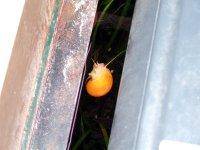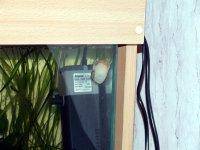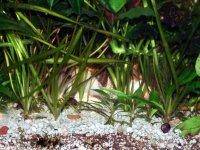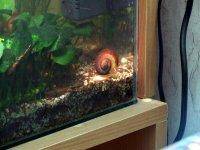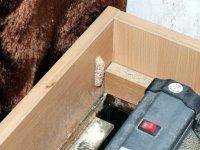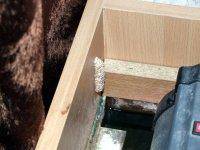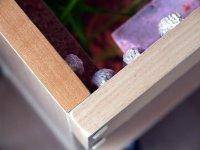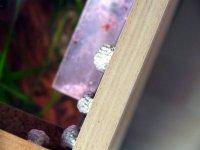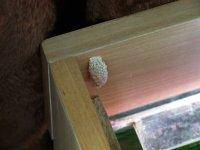Mystery or Apple snail – Care, Breeding, Detailed characteristics, Pictures and Forum
Quick navigation – Answers
- Mystery snail or Apple snail?
- Body
- Do Mystery snails pee?
- Where to keep Apple snails?
- Water conditions they require
- Be careful with the medications
- Who to keep them with?
- What do they eat?
- Is there a male and a female Mystery snail?
- How do Apple snails breed?
- The right way to transport Mystery snails
- How many kinds of Apple snail there are?
- Can I eat my apple snail?
Brief Description
This page contains all information necessary for raising Mystery snails in fish tanks - from basic care to breeding and compatibility; All with forum and pictures, questions and answers. We'd love to hear about your Mystery snails! Once you're finished reading this article go to the bottom of this page and send us your story, please! On aqua-fish.net there are other pages that you might be interested too: Types of aquarium snails with forum and Ramshorn snails with forum.
Apple snails are one of the most favourite snails bought for home aquariums. They are often called Mystery snails, since at first nobody in the aquarium trade knew what kind of snail they were. However they became quickly very popular not only because of their looks, but also because they eat fish food remains and algae from the glass and decorations. Since some species will eat aquarium plants too, you have to be careful in choosing the right snail for your tank. Unfortunately the salesperson will not always be able to tell you which kind of snail from the family Ampullariidae he sells, therefore I hope this article will come handy in recognizing each species and also in giving the best care. But lets describe an Apple snail first.
Body parts of a Mystery snail
The visible parts are the shell, foot, head, and the part which distinguishes all Apple snails, the shell door – operculum (except in the Pilla, their door calcifies at the inside). They carry the door on the back side of their foot so when the snail retrieves into its shell, the operculumseals the shell and protects the most vulnerable part. We can see three pairs of tentacles and a mouth on their head. One pair of tentacles carries the eyes, another one is the cephalic tentacle and the last one is the labial tentacle. The cephalic tentacle is the longest, and the length of it is another way how to distinguish one species from another. Of course if you have some fish which like to nip at the snail's tentacles, it will quickly learn not to extend them more than necessary. And that is a pity, since only once they are fully outstretched their true beauty is visible. Sometimes you can see a breathing tube peaking out from under the shell. Its length is another way to tell apart some species. They move just as the ordinary snails do, they use their muscular foot. But these underwater snails can also float the same way submarines do. They store air under their shell and when one wants to get to the surface, it just lets out all the water and the air will take the little diver to the surface. The foot is not only used for movement, but also as a food collector. If a snail senses food on the surface, it will climb just under the water and make a cone out of the front part of its foot, while the rest stays attached to the glass or something that reaches to the surface. The cone will then collect all the floating food and the feast can begin.
How does the body of an Apple snail work?
Snails function, mostly, on the same principle as other animals on this planet. They have a heart, even if with only two chambers, which distributes the blood trough the whole body. The biggest difference in blood circulation is, that they don't have veins and arteries. Their blood circulates freely between their cells and organs and the oxygenated blood mixes with deoxygenated. It is called an open circulation. And their blood is not red, since it does not contain hemoglobin, but hemocyanine. Another interesting thing about their blood is, that it is used to move the whole body, since they do not have any bones. If an apple snail needs to extend its, for example, testicle, it sends enough blood into it to swell up and reach as far as the snail wants. Their blood is also cleaned trough kidneys and yes, they do pee.
The blood is at one point going trough the respiratory system, where it gets oxygenated. Mystery snails can breathe by lungs or by gills, since they are very well adapted to the environment where they come from. They use lungs when there is very little oxygen in the water and breathe air from above the surface, or they use gills and absorb it from the water and not risk being an easy target for predators above the water. Their gills work just as the gills on an ordinary fish, but when they breathe trough lungs, they do not use noses, but they extend their breathing tube – siphon above the water surface and starts to pump the air under the shell where it is stored and used for breathing.
Their digestive system begins at their mouths equipped with teeth. They use them for biting and grinding off food, then the food goes to the stomach, which is U shaped and divided into three sections. Here it is mixed with enzymes and slime and broken down. The digested food goes to the intestine where all the nutrients are absorbed by the walls and introduced right to the blood stream. The remains of the food goes out by the anal papilla situated in the shell opening.
Senses
From all of the senses, smell is the most developed by Mystery snails. It is the most helpful when searching for food. They don't see well, their eyes are mostly useless and they are completely deaf too. That leaves touch as the only sense they can depend on while moving around. They extend their tactiles and feel the surrounding terrain around them. More-so, their whole body is covered by receptors which can detect pressure changes, but also molecular composition of the surrounding water like its pH or amount of oxygen and so on.
The tank
If you want only Apple snails in a tank, it should have 10 liters (2.64 US gallon, 2.20 Imperial gallon) per every 5 cm (1.97 inch) large snail, or per every snail that will grow that large. The water level should be 2x higher than the snail's shell and since it can vary, be sure what kind of snail you're buying. For example Pomacea maculata can grow as large as 15cm (5.91 inch). Every tank with Mystery snails, should have some free space between the water surface and the hood. It is not just because some snails lay their eggs above water, with these you need about 15 cm (5.91 inch) space, but also for the possibility that they would want to go to the surface and breathe in some atmospheric air. Atop this free space always leave a hood or some cover, since they often sneak out of the tank and the fell from the aquarium to the floor could be fatal. They do not need light in the tank, since as mentioned, their eyesight is horrible anyway and the natural light in the room will be enough for them to tell if it is day or night, unless you want to have plants with them there. On the other hand if you want to breed them, light will ensure algae growth and small snails will have readily available food from the beginning.
The water can be crystal clear or murky and without air. They are adapted to live in both conditions since the water in the rivers vary trough the year. For example, when the dry season comes, the water surface is low and muddy, or there is only mud in the end and they have to survive buried in it. They simply retreat into their shell and close the “door” and wait until the rain comes. Since they have both gills and lungs, water does not have to be well aerated. If they need, they simply go up to the water surface, extend their breathing tube and start to suck in the air. This can also be useful as an indicator if you need to add more air into the water.
Water conditions
Apple snails are generally not very sensitive to the water condition, however their water should be rich in calcium. Otherwise their shell start to dissolve. First, some holes might appear, the surface will be ragged and not shiny as it should be. In the end even a small pressure or bump can cause a crack. Another thing that Mystery snails hate in their water are heavy metals. The most dangerous is copper. Naturally high levels of ammonia, nitrites and nitrates or pH outside of the 6,5 – 7,5 range will be deadly for most of the living creatures. If suddenly all the snails at once will try to get out of the water, it probably will mean something is not right with the water and your first reactions should be to exchange about 50% of the water in the tank for clean dechlorinated water. Otherwise regularly change about 10 – 25% of the water, depending on the efficiency of your filtration system, since Apple snails produce lot of waste. Mystery snails are tropical snails, so the optimal temperature should be between 20 to 28°C (68 to 82.40°F). Of course some Ampullariidae snails like Pila globosa will not survive extended periods of time with only 20°C (68°F) in the tank. Most of the snail will close them elves into their shells and hibernate if the temperature drops to 18°C (64.40°F), and if it drops even more, some snails will die within few hours, some within days. The best temperature for breeding is 28°C (82.40°F), but if it rises into extremes like 38°C (100.40°F), they will survive just few hours. Temperature affects the length of their life too. They will be less active in colder waters, which can extend their life span up to 4 years and in 26°C (78.80°F) water they should live about 2 years.
Mystery snails and medications
If some disease shows up in your tank and you want to treat the whole tank at once, you should be very careful, because snails do not tolerate fish medications well, especially the copper based ones. Which is reasonable, since the medications are mostly just for fish and are toxic to snails. This is another reason why it is important to treat your fish only in quarantine aquariums. But if that is not possible, take at least the snails out into another tank until all the traces of the medications are gone.
Tank mates
The safest bet is to have only shy and peaceful fish with Apple snails. Those fish are for example tetra, catfish and corydoras. A bit of a problem might occur with curious fish like angelfish or gourami. They might sometimes bother them. Botias and paradise fish will be more aggressive toward these snails and you definitely should avoid tetraodons and other snail eating fish. But the more big is the snail, the more secure they should be.
Feeding
Despite the fact, that there are lots of different kinds of Mystery snails, you should feed them mostly with plant based foods. But they will eat everything other fish haven't eaten up like flakes, pellets, dried shrimps floating on the surface, frozen food and so on. Young snails might also eat algae if it is available, but older ones rather wait for food delivery, since eating fish food is easier than grinding down algae. Some snails, like Pomacea diffusa, like decaying plants more. On the other hand, some will eat living plants (Marisa cornuarietis, Pomacea canaliculata, Pomacea maculata and Pomacea paludosa), they might even eat every plant in your tank. From what you have in the fridge, you can give them slices of carrot, cucumber, potato or lettuce, but clean it thoroughly first. If it is possible, try to buy the organic ones, so they would not get poisoned by the remaining inorganic fertilizers, herbicides or pesticides. At the same time, most of Apple snails are also scavengers and will eat any dead fish laying around or even other snails. Fish that are still alive are perfectly safe since they do not have any way of catching them, but fish eggs are quite the easy target, even if they are in a bubble nest.
Breeding
Mystery snails are gonochoristic, which means there are male and female snails and you obviously will need both sexes for breeding. As it was mentioned above, they will need higher temperatures for breeding, but more food is very important too. Finding any difference between a male and a female snail is almost impossible, but the best chance you get will be during the actual mating when a male will climb a female and releases his seed into her trough a tube similar to the breathing siphon they only extend during mating. The amazing thing about female Apple snails is, that they do not have to let the sperm fertilize the eggs right away, she can wait few months. Then she makes a cocoon out of them and leaves the small snails to hatch and carry for themselves. These cocoons can be left either under the water, or above it. Sometimes, if there is no male in the tank, a female can make a cocoon out of unfertilized eggs. One pair of snails can produce one cocoon every 6 days for few weeks and they will reproduce mostly during spring and summer. If the female lays her eggs above the water, the air surrounding it should be very moist, but the eggs must not be wet and you definitely cannot put them under the water. A cocoon can be moved, but you have to be very careful. The easiest it is to remove them from the glass and similar smooth surfaces. First, wet the cocoon but only where it is in contact with the glass and then try to move it a bit until it falls off. After that place the cocoon into a moist place above a tank with 28°C (82.40°F) water. The warmer the air surrounding the eggs will be, the sooner the eggs will hatch, just don't overdue it with the warmth, it still should take few weeks. If they don't hatch even after 4 weeks, carefully break the cocoon to find out if there are any snails. If you find them, submerge the cocoon under the water to help the little ones to swim away. But if there are no snails, it means the eggs were not fertilized, or the air around the eggs was not moist enough and the embryos were not able to eat the too thick yolk. At the end of the 4 weeks you might moisturize the cocoon to soften the shells and make it easier for little snails to hatch.
According to the method of breeding, we can divide Apple snails into categories:
- snails laying they eggs above the water surface - Pomacea, Asolene pomella, Pila,
- snails laying they eggs under the water surface - Asolene asolene, Felipponea, Marisa and Lanistes. These snails make the cocoon out of a substance close to jelly. It is transparent, so you can watch how the little snails grow.
- Special category belongs to Pomacea urceus. Female of this species keeps its eggs under the shell and when the snails are ready, they just crawl out from under it. Unfortunately, this kind of breeding leaves marks on the females shell where the eggs were attached.
Little snails will eat the same thing as their parents, so you don't have to prepare or buy any special food. You just have to deliver the food to the little guys, since they should not spend all their strength to cross wide distances to find their food. That is the reason why it is an advantage to have algae growing all around the tank, so everywhere is readily available food. Adult snails will not pay any attention to their young, problem might be caused only by small snails eating fish living in the same tank.
Purchase and transport
If you buy a Mystery snail, you probably will get it in a plastic bag, sometimes with water, sometimes without it. This way is acceptable only for short distance traveling. If you have a longer road ahead of you, you should transport them in small plastic containers with wet towels surrounding the snails, so the shell would be protected. The container should have enough air in it, or it can have holes in the cover. For really long distances the holes are a must.
Kinds of Apple snail
Apple snails can be divided into 8 genuses: Afropomus, Asolene, Felipponea, Lanistes, Marisa, Pila, Pomacea and Saulea. These cover about 120 different species of snails, but since it is very difficult to tell them apart, there actually will be less species than that. The most obvious differences can by found on the shell, but some species look so alike, that you can't tell them apart just by simply looking at them, or their shells look nothing alike only because of some external forces, not because of the DNA.
- Afropomus
Comes from small part of Central Africa and it is quite rare. Only one Apple snail belongs here: Afropomus balanoideus. Its body is black or gray, the shell is yellow or brown with dark lines and the breathing tube with the tentacles are short.
Asolene
They can be found in two parts of South America. One is in Paraguay and Southeastern Brazil and the second is near the Argentina, Brazil and Uruguay borders. The most distinguished difference between other and this genus is the short breathing tube. They live in fast streams full of air, so they do not use it very often. Snails from this genus are divided into two sub-genera Asolene and Pomella. But since Asolene makes its cocoons under the water and Pomella above it, biologist think the whole Pomella sub-genera should be under Pomacea genus.
Asolene (Asolene) spixi have a golden shell with variously wide almost black bands on it. Each of these bands start at the shell opening and end by the shell's spiral. This is one of the slowest Mystery snail and you won't see them much during the day, since they spend it berried in the substrate. If the temperature is not high enough, they won't even get out of it at all.
Asolene (Pomella) megastoma's shell spiral is almost totally flat and the shell can grow up to 10 cm (3.94 inch). It often looks fragile and damaged with something that looks like little holes, but it is normal and the shell despite its looks is strong. It can be brown to green, the foot is beige but the corners of are purplish and it is decorated with yellow dots. As mentioned, this Mystery snail leaves his cocoon above the water and the eggs are pink. They can be found in rivers with fast streams, so their hold is very strong and it is quite hard to move them once they take hold of something in the tank.
- Felipponea
Felipponea is a genus that comes from a small part of South America somewhere between Argentina, Uruguay and Paraguay. They live in rivers with strong streams and their shell is more aerodynamic than shells of other Apple snails. The shell's spiral is on the right side, but it is pointed more to the back than by other Mystery snails. And because, in nature, it lives in waters rich on oxygen, and it hardly ever uses its very short breathing tube. Since they spend so little time above the water, it is understandable that they also leave their eggs under the water.
Only tree species belong into this genus and Filipponea neritiformis is one of them. The shell is somewhere between brown-green and it is a bit easier to tell a female from a male with this species. The female's shell opening is longer, but nearer than a male's. Their body is dark brown.
- Lanistes
In nature, they are almost all over Africa. The main difference between these and other Ampullariiadae snails is, that their shell's spiral is not on the right, but on the left side and their breathing tube is very short.
Lanistes lybicus is one of the snails in this genus. Its body is brown and the shell is light brown to dark brown. They make their cocoon under the water and since they will not eat any or your aquarium plants, they are plant safe.
- Marisa
This genus lives only in tropical forests of South America and only the Marisa cornuarietis species belongs here. Since it is so different from other Ampullariidae snails, it is often not even recognized as one of the Apple snails. It is because their shell looks more like a ramshorn snail's, which is why they are sometimes called giant ramshorn snails in the aquarium trade. The shell is narrow, tall and almost flat, with the spiral not pointing into any direction, but to the inside of the shell. The shell can be yellow to dark brow with or without any stripes and it can be as high as 6 cm (2.36 inch). The body is light with dark-brown or black markings or it can be dark with yellow markings. They lay their eggs under the water.
- Pila
Mystery snails from this genus can be found in almost every river of Africa and in the south of Asia. They make white cocoons above the water.
Pila ampullacea's shell can grow up to 10 cm (3.94 inch) and the shell can have various colours on it. It can have yellow, green or even red stripes and the stripes can be either horizontal or vertical. The shell itself is globose, smooth and the shell's spiral is standing out only a little in comparison to most of the Apple snails. They eat various plants and algae, so they are not suitable for aquarium with plants and in some countries they are seen as food and eaten.
Pila globosa is very similar to Pila ampullacea. The only difference is, that globosa's shell opening is a bit wider. These snails are mostly used as food for shrimps on shrimp farms in Asia.
Pila virens has brown to black body with a light underside of the foot. The shell's spiral is much more defined than by the above mentioned ones. The shell can grow up to 7 cm (2.76 inch) and it can be green to brown with lighter stripes. It will eat all the plants in the tank.
Pila wernei is one of the biggest Apple snails. It can grow up to 13 cm (5.12 inch). The shell's spiral is short and bulky. In nature, it mostly lives in calm waters were it feeds on various plants.
- Pomacea
This is the largest genus. It comes from South and Middle America, but it was introduced into South Asia where they wanted to breed it for food (it was the Pomacea canaliculata species). But its taste was not very good and it eventually escaped into the wild, where it now destroys rice fields. Pomacea is the most common Mystery snail. It breeds above the water and it has long breathing tube and tentacles.
If you walk into a store where they sell snails, it is very likely that it will be one of the Pomacea genus. Specifically it should be the Pomacea diffusa. Pomacea diffusa and Pomacea bridgesii were for long time seen as one specie, but after a mitochondrial DNA test, they were divided. The test showed, that Pomacea bridgesii is very rare, so if you see one in a pet shop, it probably really is a Pomacea diffusa.
The tops of diffusa's shell's spirals are almost straight lines and flat, and their angle is very close to 90° with the shell opening. It can grow up to 6,5 cm (2.56 inch) and it can be golden, brown, black with or without stripes. The body is usually yellow with markings, but rarely it can have dark body with an almost white shell. It will eat decomposing plants and ordinary fish food and vegetables. The cocoon stuck above the water will get pink after few days.
Pomacea canaliculata is another common Mystery snail in pet shops. The shell can be brown, brown-green, light brown, light brown-green, golden, with stripes or without them and it can grow up to 7,5 cm (2.95 inch). The shell opening by diffusa is shaped almost like a leaf where the point points in the same direction as the spiral, but by canaliculata, the point is bent almost vertically to the spiral. It will eat aquarium plants and it's cocoon will turn orange.
Pomacea maculata is the biggest Apple snail. It can be somewhere around 15 cm (5.91 inch). The shell is green with delicate black stripes and when you peek inside, it should have dots there. It is not commonly kept in tanks, but their cocoons are green.
Pomacea flagellata flagellata has one of the prettiest shells of them all. The shell opening is almost a perfect teardrop, and the spirals on the shell are very smooth. The shell itself can grow up to 6 cm (2.36 inch), it is dark-brown-green with lighter stripes. At one point the lip of a males shell will start to grow outwards. Some say it is to block other males from mating with a female while one is already on her. This Mystery snail loves plants and will have no problem with eating up the whole tank. The cocoon will turn gray once it dries.
- Saulea
Saulea is very similar to Pomacea. The only difference is, that Saulea has a short breathing siphon. They are rare and live only in small part of Africa, somewhere around Guinea and Sierra Leone.
Apple snails: pets or food?
All Mystery snails are eatable and rich on proteins, many people even say they are delicious. In some parts of the world, where there is not enough ordinary meat for the population but plenty of snails, they became the main source of proteins in the diet. For example 100g (3.52 ounce) Pomacea species contains 83 calories, 12 g (0.42 ounce) proteins and only 0,4 g (0.014 ounce) fat.
If you would like to breed your own food source in a tank, or you'll find yourself lost somewhere in the wild and the best way to survive is eating some Apple snails, you have to know that it is very important to cook them properly. Mystery snails can contain lots of parasites so never eat them raw. The best is to keep them in clean water for two days to get rid of all the remaining food in their digestive system. After that use only the living snails. The kindest way to kill any invertebrates with a shell is freezing or throwing them into boiling water. Cook for about half of an hour in boiling water, then it is easier to separate the body from the shell. Throw the intestines away, since they taste nasty, only the foot should be eaten. Now the meat is ready and you can use it in various ways as ordinary meat like deep frying, with pasta, in sauces, soups and so on.
I hope this article has convinced you of the benefit of keeping this creature-trust me, you will not be disappointed.
Pictures
Links to related articles located outside of aqua-fish.net
- Feel free to visit Care of Ornamental Snails at firsttankguide.net too!
- Apple Snails and Bettas at nippyfish.net!


















